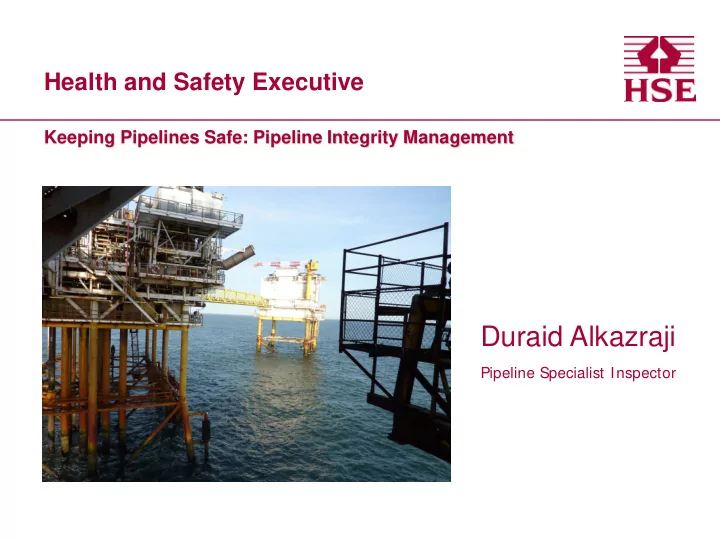

Health and Safety Executive Keeping Pipelines Safe: Pipeline Integrity Management Duraid Alkazraji Pipeline Specialist Inspector
This is what I intend to cover • HSE’s role • Why is Integrity Management so Important • Legislation - Pipeline Safety Regulations • Standards • Integrity Management – PIMS • Key Messages
HSE’s Role • Specialist Inspector within Energy Division gas and pipelines unit. – Inspection of pipeline operators – Investigation of Accidents and Incidents – Enforcement Action • Improvement Notice • Prohibition Notice • Prosecution – HSE is not a first responder • HSE is a Category 2 responder under the Civil Contingencies Act 2004 and plays a supporting role in emergency planning and response. Inspectors should not become involved in the incident command and control arrangements established by Category 1 responders
HSE’s Role UK North Sea and Irish Sea • The UK offshore oil and gas industry consists of 107 oil and gas plus 181 gas producing installations, located on 383 producing fields. There is a supporting infrastructure of 14,000 km of pipelines connecting installations to beach terminals. Industry commissioned many of these assets in the early 1970s and some are now forecast to continue operating to 2030 and beyond • Currently, the majority of activity is in the North Sea, with other activity in the Irish Sea and West of Shetland • Operators and contractors employ over 32,000 workers in offshore activities • Oil and gas production is strategically important to the UK economy, meeting around 50% of our total primary energy needs
Why is managing UK Offshore pipeline integrity important • Original design life typically 25 years • Approx 25% of UK offshore pipelines have exceeded original design life • Current projections are that this will increase to 50% by 2020 • Likely continued and extended production from existing fields • Challenges from deeper, hotter and higher pressure fields
Why is Managing Pipeline Integrity Important? • Safety risk • Environmental damage • Reputation • Legal requirement • Production facility down time • Loss of production/profit • HSE approach is identical for onshore and offshore pipelines
Why is Managing Pipeline Integrity Important?
The Pipelines Safety Regulations (PSR) • PSR (primary legislation) replaced earlier, prescriptive legislation • focus on management of pipeline safety – to secure pipeline integrity – cover both onshore and offshore pipelines • overall aim: ensure that pipelines are designed, constructed, operated and maintained properly
The Pipelines Safety Regulations (PSR) • Scope of Regulations –refer to PSR Reg 3;
The legal framework • Pipeline Safety Regulations • Regulation 13, Maintenance is essential – Maintain to ensure remains safe and fit for purpose – Consider maintenance and inspection requirements for the pipeline – Maintenance under this regulation also includes maintaining any safety system
• Regulation 23, Major Accident Prevention Document Identify hazards relating to the pipeline Record and document findings Implement a management system Revise and replace MAPD as appropriate
Integrity Management Standards
Integrity Management Standards
Integrity Management - The aging pipeline – physical challenges • Aging – not simply related to chronological age • Aging is a product of corrosion, fatigue, erosion, damage, modifications, changes to flow rate etc over time
Failure Probability Testing Intended design life Construction Operational life Time [Failure probability verses time]
Aim is to maintain Integrity • Fit for Service as per PSR Reg 13 • Managing Deterioration is the Key
Integrity Management • Must show clear management focus on major hazards and pipeline system safety. • Essential to have effective record keeping and management/data analysis. • 'Threat identification' should be well thought out and robust. • Pipeline repairs must be planned and managed. • Resources available for pipeline integrity assessments must be effectively managed • Bottlenecks or unexpected operational issues must not mean important work not done (e.g. repairs or assessment work) Source: NTSB
Integrity Management • Major theme of HSE’s strategy • Must permeate throughout the organisation • Take ownership of risks and managing them • This is a strategic challenge
PIMS – Key Elements Documentation Risk Profiles Pipeline Data - Well documented processes - Damage - ILI and procedures - corrosion - CP -Spanning - Defects -Buckling - Pipeline changes Trends Maintenance/ - Frequency of events PIMS (Corrosion, Repair Plans (Pipeline Integrity Management System) Spans, movement, other) Quarterly, GIS Annual Asset Reports Register
Key Messages • The people best placed to make workplaces safer from harm are the staff and managers who work in them • We are committed to being a good partner – working with others to improve pipeline safety • PSR provides a single framework for pipeline safety & integrity with a goal setting focus • Drive to continue improvement in safety record for UK pipelines • Sensible health and safety approach
Key Messages • Pipeline Integrity Management remains a key priority focus for HSE, both offshore and onshore. • HSE expect duty holders to have robust/effective integrity management systems throughout the pipeline lifecycle: – Systems should reflect good practice and must be subject to regular monitoring, audit and review – Strong leadership, effective use of SPI’s and sharing of lessons learned and good practice are important factors • Formal review of Pipeline Life Extension expected in line with good practice
Key Messages • Asset Age (deciding when is revalidation necessary) • Ensuring competent staff and follow and apply safe systems of work • Ensuring operators follow industry best practice • Effective procedures in management of pipelines and risers • Operational Intelligence – ESD performance testing and trending (pipelines) – Key Performance Indicators – Quarterly & Annual Integrity Reviews • New developments in technology – E.g. Integrity management of flexibles • Decommissioning and the management of projects
Recommend
More recommend